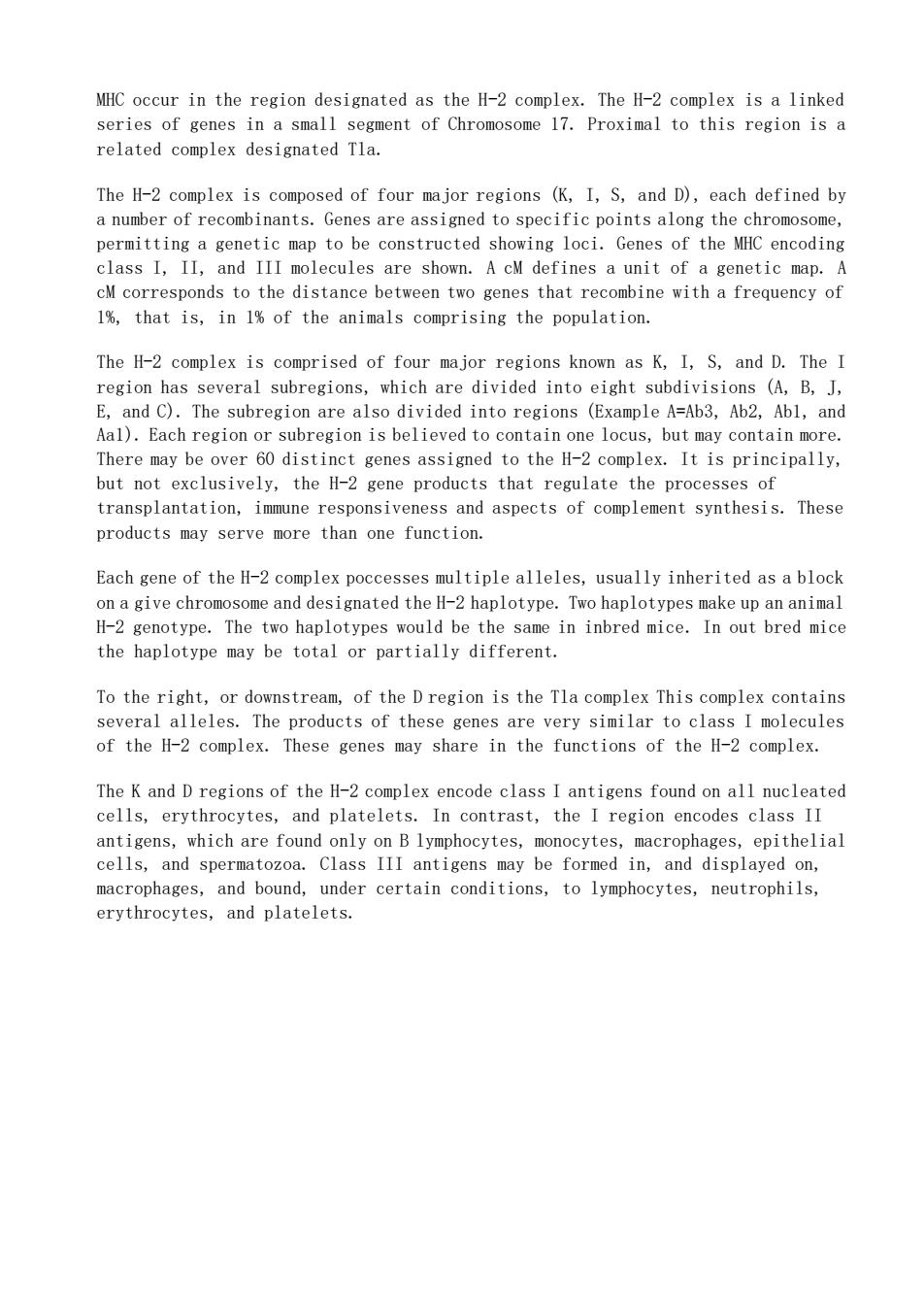正在加载图片...

MHC occur in the region designated as the H-2 complex.The H-2 complex is a linked series of genes in a small segment of Chromosome 17.Proximal to this region is a related complex designated Tla The H-2 complex is composed of four major regions (K,I,S,and D),each defined by a number of recombinants.Genes are assigned to specific points along the chromosome, permitting a genetic map to be constructed showing loci.Genes of the MHC encoding class I,II,and III molecules are shown.A cM defines a unit of a genetic map.A cM corresponds to the distance between two genes that recombine with a frequency of 1%,that is,in 1%of the animals comprising the population. The H-2 complex is comprised of four major regions known as K,I,S,and D.The I region has several subregions,which are divided into eight subdivisions (A,B,J, E,and C).The subregion are also divided into regions (Example A=Ab3,Ab2,Abl,and Aal).Each region or subregion is believed to contain one locus,but may contain more. There may be over 60 distinct genes assigned to the H-2 complex.It is principally but not exclusively,the H-2 gene products s that regulate the processes of transplantation,immune responsiveness and aspects of complement synthesis.These products may serve more than one function. Each gene of the H-2 complex poccesses multiple alleles,usually inherited as a block on a give chromosome and designated the H-2 haplotype.Two haplotypes make up an animal H-2 genotype.The two haplotypes would be the same in inbred mice.In out bred mic the haplotype may be total or partially different. To the right,or downstream,of the D region is the Tla complex This complex contains several alleles.The products of these genes are very similar to class I molecules of the H-2 complex.These genes may share in the functions of the H-2 complex. The K and D regions of the H-2 complex encode class I antigens found on all nucleated cells,erythrocytes,and platelets.In contrast,the I region encodes class II antigens,which are found only on B lymphocytes,monocytes,macrophages,epithelial cells,and spermatozoa.Class III antigens may be formed in,and displayed on, macrophages,and bound,under certain conditions,to lymphocytes,neutrophils, erythrocvtes.and platelets.MHC occur in the region designated as the H-2 complex. The H-2 complex is a linked series of genes in a small segment of Chromosome 17. Proximal to this region is a related complex designated Tla. The H-2 complex is composed of four major regions (K, I, S, and D), each defined by a number of recombinants. Genes are assigned to specific points along the chromosome, permitting a genetic map to be constructed showing loci. Genes of the MHC encoding class I, II, and III molecules are shown. A cM defines a unit of a genetic map. A cM corresponds to the distance between two genes that recombine with a frequency of 1%, that is, in 1% of the animals comprising the population. The H-2 complex is comprised of four major regions known as K, I, S, and D. The I region has several subregions, which are divided into eight subdivisions (A, B, J, E, and C). The subregion are also divided into regions (Example A=Ab3, Ab2, Ab1, and Aa1). Each region or subregion is believed to contain one locus, but may contain more. There may be over 60 distinct genes assigned to the H-2 complex. It is principally, but not exclusively, the H-2 gene products that regulate the processes of transplantation, immune responsiveness and aspects of complement synthesis. These products may serve more than one function. Each gene of the H-2 complex poccesses multiple alleles, usually inherited as a block on a give chromosome and designated the H-2 haplotype. Two haplotypes make up an animal H-2 genotype. The two haplotypes would be the same in inbred mice. In out bred mice the haplotype may be total or partially different. To the right, or downstream, of the D region is the Tla complex This complex contains several alleles. The products of these genes are very similar to class I molecules of the H-2 complex. These genes may share in the functions of the H-2 complex. The K and D regions of the H-2 complex encode class I antigens found on all nucleated cells, erythrocytes, and platelets. In contrast, the I region encodes class II antigens, which are found only on B lymphocytes, monocytes, macrophages, epithelial cells, and spermatozoa. Class III antigens may be formed in, and displayed on, macrophages, and bound, under certain conditions, to lymphocytes, neutrophils, erythrocytes, and platelets